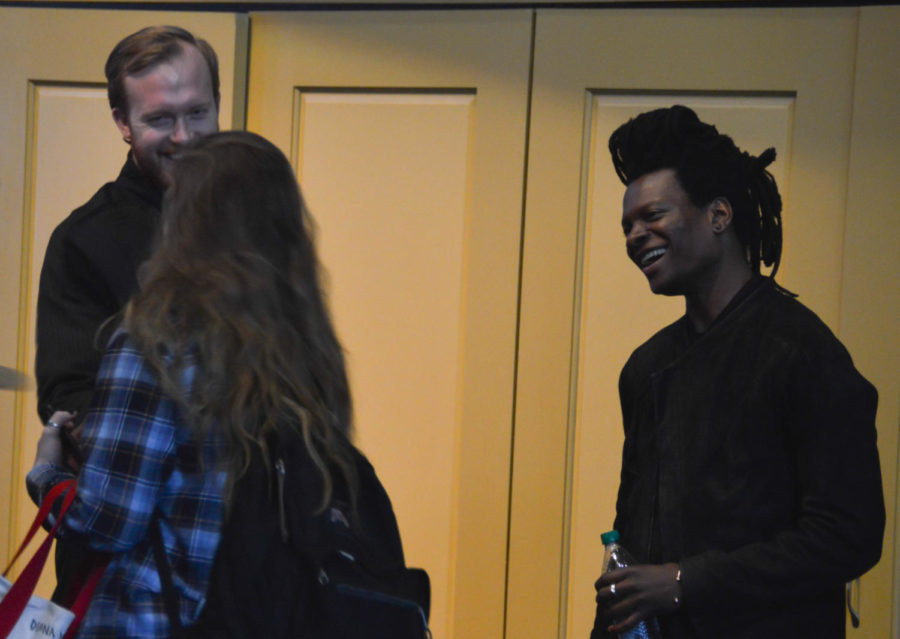Designers behind Abasi Rosborough talk influence, advice
Maddie Leopardo/Iowa State Daily
Greg Rosborough (left) and Abdul Abasi (right) interact with students after giving a lecture on the business of menswear in Curtiss Hall on April 6. Their label offers a reinvention of the classic men’s suit. Rosborough and Abasi will be the guest designers featured at the Fashion Show April 8.
April 6, 2017
Clad in their self-designed black jackets, it was evident that Abdul Abasi and Greg Rosborough know a thing or two about fashion design.
Abasi and Rosborough met when studying at the Fashion Institute of Technology in New York and have since created their own menswear line that combines military and athletic silhouettes under the label, Abasi Rosborough.
Their clothes are designed to emphasize range of motion and versatility. After releasing their first collection in 2013, the duo has since been recognized by The New York Times, Vogue, GQ Style and many more.
Abasi and Rosborough presented to a group of about 40 students in Curtiss Hall Thursday evening. The two will also be guest designers for the Iowa State Fashion Show and display their collection on Friday.
Born in Iowa, Rosborough had no intention of pursuing design when he was younger despite his creativity.
While on a basketball trip to New York as a teenager, Rosborough left his team and ventured to Barneys.
“It was my first time seeing real interesting fabrics, real interesting design concepts,” Rosborough said.
Although Rosborough was studying business in Arizona, he was destined to get back to New York.
Abasi grew up in Washington, D.C., and Maryland. The diversity he witnessed among these two states inspired him to design interesting and versatile pieces.
At the age of 17, Abasi went to Fort Knox, Kentucky, with the intention of joining the army. As an apache attack helicopter missile systems technician, Abasi was stationed in Europe. While abroad he noticed fashion being used as an art form in a way that he hadn’t previously seen.
Abasi’s commander encouraged him to take on fashion design, saying, “That’s fine but make sure I get the first Abasi suit.”
After meeting at school, Abasi and Rosborough bonded over “making things that have a reason for being,” Abasi said.
“Fashion is all about storytelling,” Rosborough said.
While in school, Rosborough nabbed his first internship at Ralph Lauren. He was fascinated with the lux state of the clothing compared to the cheap fabrics he and Abasi would purchase for school projects.
However, while at Ralph Lauren, Rosborough was caught in a spiral of looking into past Ralph Lauren collections to design vintage-inspired clothing.
Although this experience helped Rosborough in his career, he was interested in creating new modern fashion that hadn’t been seen before.
Abasi recalls his first internship with Patrik Ervell as something he never imagined he would be doing. When his boss was unable to finish a gold-foil mylar jacket because of the complicated fabric, Abasi was tasked with fixing the problem.
As the garment walked down the runway Abasi realized that he was capable and had potential to design.
Abasi and Rosborough wanted to challenge the “gold standard of menswear” to create a menswear suit that would evolve for the 21st century audience.
Intrigued by upgrading the typical business jacket that they saw while taking public transport in New York, Rosborough and Abasi wanted to make the suits more flexible for the working man.
With the intention to reinterpret the restrictive shapes of traditional menswear, Abasi Rosborough was born.
After creating the designs for their first pieces, Rosborough and Abasi contacted a local model casting agency to enlist models for their clothing.
“We want [the model] to look like he can exist 10,000 years in the past and 10,000 years in the future,” Rosborough said.
With their first collection, Rosborough and Abasi experienced a great deal of rejection as they wouldn’t receive feedback on their collection from any companies they sent their work to.
To combat this Abasi suggests “[using] your network” to contact people in the fashion industry with connections to you that may not be obvious but are there.
Abasi and Rosborough got in touch with Barneys to present their first collection.
They were so eager for the meeting they walked their clothes to Barneys on a clothing rack sans garment bags.
After their first collection only made one sale to a store in Japan, the two jetted off to an affordable Airbnb in Paris to show their clothes to buyers who they couldn’t get in touch with in New York.
Abasi and Rosborough cited travel as an influence for their designs. Their collections have been inspired by a Richard Serra art instillation in Qatar and architecture and design in Hong Kong.
Their most recent collection, which they’ll be showing at The Fashion Show on Friday, was inspired by an image they saw of a young woman standing in a street being charged by policemen during a protest.
Courtney Johnson and Ashney Williams, graduates in apparel, events and hospitality management, both plan on attending The Fashion Show and are exciting to see Abasi Rosborough clothing.
Johnson’s biggest takeaway from the lecture was hearing the design duo mention adding all previous expertise into a résumé regardless of its relation to fashion and being persistent when reaching out for job opportunities.
“Both of us are from the South, so we’re trying to be polite and proper all the time,” Johnson said. “I thought it would be annoying to nag companies. But them being industry people saying that it’s OK to be persistent made me feel better.”
Williams mentioned Abasi and Rosborough’s advice on creating your own self-initiating projects for companies you like as something she will be inspired to do.







